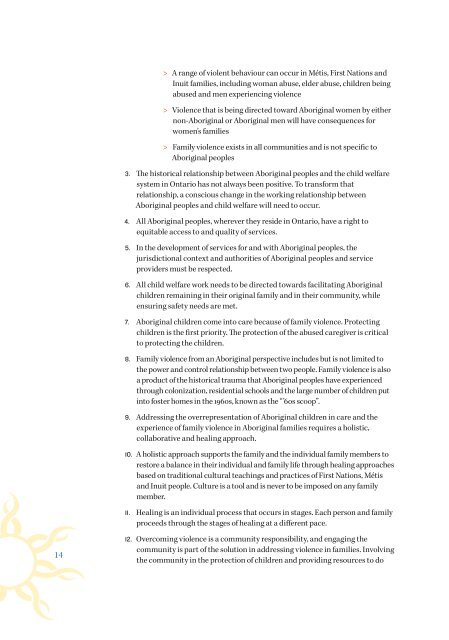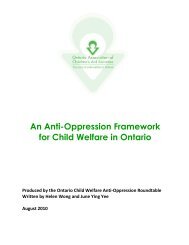English - Ontario Association of Children's Aid Societies
English - Ontario Association of Children's Aid Societies
English - Ontario Association of Children's Aid Societies
Create successful ePaper yourself
Turn your PDF publications into a flip-book with our unique Google optimized e-Paper software.
A range <strong>of</strong> violent behaviour can occur in Métis, First Nations and<br />
Inuit families, including woman abuse, elder abuse, children being<br />
abused and men experiencing violence<br />
> > Violence that is being directed toward Aboriginal women by either<br />
non-Aboriginal or Aboriginal men will have consequences for<br />
women’s families<br />
> > Family violence exists in all communities and is not specific to<br />
Aboriginal peoples<br />
3. The historical relationship between Aboriginal peoples and the child welfare<br />
system in <strong>Ontario</strong> has not always been positive. To transform that<br />
relationship, a conscious change in the working relationship between<br />
Aboriginal peoples and child welfare will need to occur.<br />
4. All Aboriginal peoples, wherever they reside in <strong>Ontario</strong>, have a right to<br />
equitable access to and quality <strong>of</strong> services.<br />
5. In the development <strong>of</strong> services for and with Aboriginal peoples, the<br />
jurisdictional context and authorities <strong>of</strong> Aboriginal peoples and service<br />
providers must be respected.<br />
6. All child welfare work needs to be directed towards facilitating Aboriginal<br />
children remaining in their original family and in their community, while<br />
ensuring safety needs are met.<br />
7. Aboriginal children come into care because <strong>of</strong> family violence. Protecting<br />
children is the first priority. The protection <strong>of</strong> the abused caregiver is critical<br />
to protecting the children.<br />
8. Family violence from an Aboriginal perspective includes but is not limited to<br />
the power and control relationship between two people. Family violence is also<br />
a product <strong>of</strong> the historical trauma that Aboriginal peoples have experienced<br />
through colonization, residential schools and the large number <strong>of</strong> children put<br />
into foster homes in the 1960s, known as the “’60s scoop”.<br />
9. Addressing the overrepresentation <strong>of</strong> Aboriginal children in care and the<br />
experience <strong>of</strong> family violence in Aboriginal families requires a holistic,<br />
collaborative and healing approach.<br />
10. A holistic approach supports the family and the individual family members to<br />
restore a balance in their individual and family life through healing approaches<br />
based on traditional cultural teachings and practices <strong>of</strong> First Nations, Métis<br />
and Inuit people. Culture is a tool and is never to be imposed on any family<br />
member.<br />
11. Healing is an individual process that occurs in stages. Each person and family<br />
proceeds through the stages <strong>of</strong> healing at a different pace.<br />
14<br />
12. Overcoming violence is a community responsibility, and engaging the<br />
community is part <strong>of</strong> the solution in addressing violence in families. Involving<br />
the community in the protection <strong>of</strong> children and providing resources to do

















